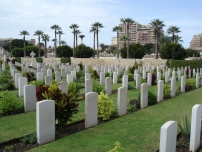| First Name: | Arthur John | Last Name: | DIXON | |
|---|---|---|---|---|
| Date of Death: | 16/08/1915 | Lived/Born In: | Woolwich | |
| Rank: | Private | Unit: | Hampshire10 | |
| Memorial Site: | ||||
Current Information:Born-Woolwich Alexandria (Chatby) Military and War Memorial Cemetery, Egypt
Gallipoli 1915 On 25 April, British, Australian and New Zealand forces landed on the Gallipoli peninsular . The plan was that these forces would soon defeat a demoralised Turkish army, knock Turkey out of the war, open up the Mediterranean to the Russian navy and threaten Austro-Hungary from the south. None of these things were achieved despite nine months of hard fighting in terrible conditions. It was an heroic failure. By July, 1915, and after much fierce fighting, stalemate had set in at Gallipoli both at Cape Helles where the British and French had landed and at Anzac Cove where the Australian and New Zealand Corps were unable to break out of their beach head. Fresh troops were needed and they were on their way in the shape of four divisions from Britain and things were put on hold until they arrived. The plan for August was for a landing at Suvla Bay to the north of Anzac Cove whilst at the same time, the ANZAC Corps, reinforced by some of the new British troops would effect a breakout from Anzac Cove and establish a line across the peninsula. Whilst this was going on the troops in the south at Helles would stage a number of diversionary attacks. But it all went horribly wrong and much of the reason for this can be explained by inadequate planning and leadership. Nobody seemed to know what they were supposed to be doing and Lieutenant-General Stopford, in charge of the Suvla landings was particularly out of his depth. The landings at Suvla failed to link up with the forces at Anzac and the breakout from there did not happen despite valiant efforts by all concerned. The loss of life on all fronts was again enormous. L.A. Carlyon’s excellent book “Gallipoli” gives a superb yet chilling account of the events. While two brigades from the 10th Division landed at Suvla Bay on 6th August, 29 Brigade, which included the 10th Hampshire battalion, landed that morning at Anzac Cove and became part of the force attempting the breakout from there. That night they joined the long column that made its way northwards along the beach before turning inland to tackle the Sari Bair range. But in the pitch black of night and moving across difficult and uncharted terrain things got very congested and as far as 10th Hampshire was concerned, very little progress was made. In the end they were sent back to Shrapnel Gulley at Anzac, to try again later. This they did on the night of 8/9th August when they moved up the coast to Fisherman’s Hut and then tried to advance up Chailak Dere gully. This proved difficult in the face of Turkish shelling and with wounded streaming back down the narrow gully. Their guides got lost as well and they were not in position to take part in the advance that began at 5am on 9th August. However at 6am they did move forward north of Rhododendron Spur where they came into action and were met by heavy machine-gun and rifle fire. At dawn on 10th August there was a large enemy attack and after hanging on in their forward positions for a while, 10th Hampshire were forced back to Rhododendron Spur and then fell back further to Green Hill (Cheshire Ridge) where they remained for three days. Arthur Dixon. died from wounds on 16th August after having been taken back to a base hospital in Egypt and it is likely that he was one of the 400 casualties suffered by 10th Hampshire during tthis operation. |
||||
| « Back to Search Results | ||||
| If you think any of the information shown here is incorrect, Click Here to submit your amends and comments | ||||




